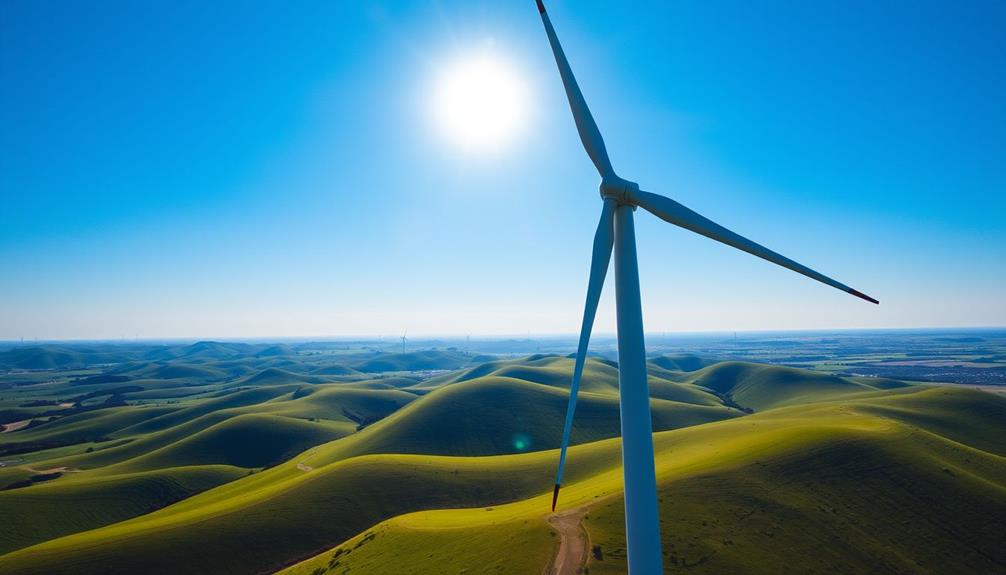Modern wind turbine blades can amaze you with their size, ranging from 84 meters for onshore models to over 107 meters for offshore designs. Some innovative projections even suggest blades could reach up to 1 kilometer long in the future. This impressive length increases the wind swept area, allowing for considerably greater power generation. Turbines with longer blades harness more energy, enhancing efficiency. As you learn more about the engineering behind these massive structures and their impact on renewable energy, you'll discover how they're shaping the future of power generation!
Key Takeaways
- Modern wind turbine blades exceed 107 meters in length, comparable to a football field.
- The average rotor diameter of contemporary turbines is approximately 438 feet (133 meters).
- Offshore wind turbine blades often surpass 108 meters, with future projections reaching up to 1 kilometer.
- Doubling blade length can quadruple power capacity, enhancing energy capture and efficiency.
- Notable models, like the GE Haliade-X, feature blades measuring 107 meters, showcasing advancements in design and technology.
Evolution of Blade Length
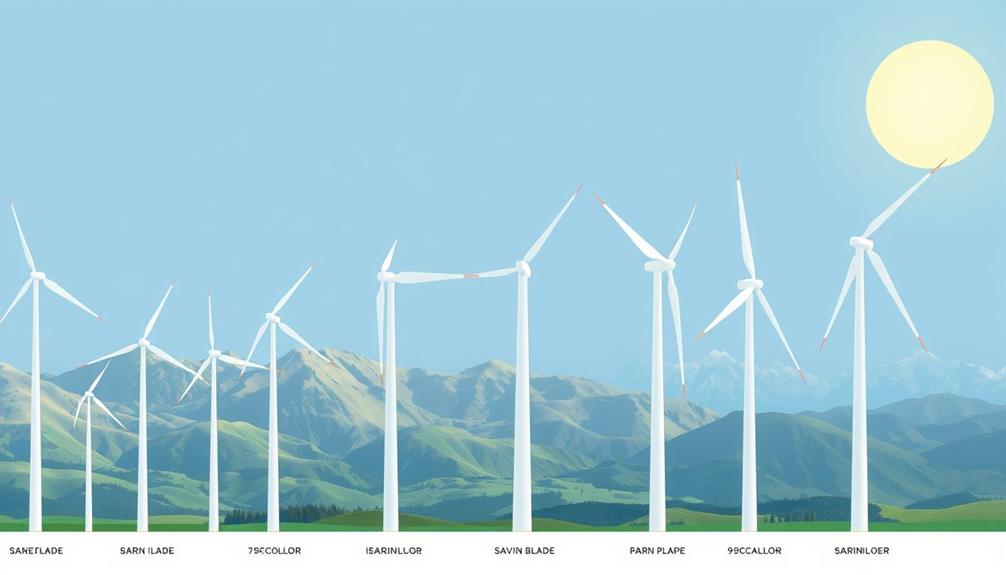
The evolution of wind turbine blade length has been nothing short of remarkable. Back in 1995, wind turbine blades were considered large at just 12 meters. Fast forward to today, and you'll see blades exceeding 107 meters, like those on the GE Haliade-X, which are comparable to the length of a football field. It’s incredible to see how long wind turbine blades have grown in just a few decades. This increase in size has allowed for greater energy production and efficiency, as larger blades can capture more wind energy. The continued development and expansion of wind turbine technology will likely lead to even longer blades in the future, pushing the boundaries of what we once thought was possible.
As the average rotor diameter of modern turbines has reached approximately 438 feet (around 133 meters), it's clear that blade length increases are a notable trend in wind energy technology. This advancement is driven by the need to capture more wind energy and improve efficiency, as weight of turbine blades varies notably based on design and materials.
This evolution reflects the growing size of wind turbines, especially with large turbines now boasting blades of 84 meters onshore and even longer ones for offshore wind turbines, extending beyond 108 meters. These advancements allow for greater efficiency and the ability to generate more megawatts (MW) of power.
As you look to the future, projections suggest that turbine blades could potentially reach lengths of up to 1 kilometer. This ongoing evolution of blade length not only showcases the advancement of wind energy technology but also highlights the commitment to harnessing wind power more effectively.
Factors Influencing Blade Size
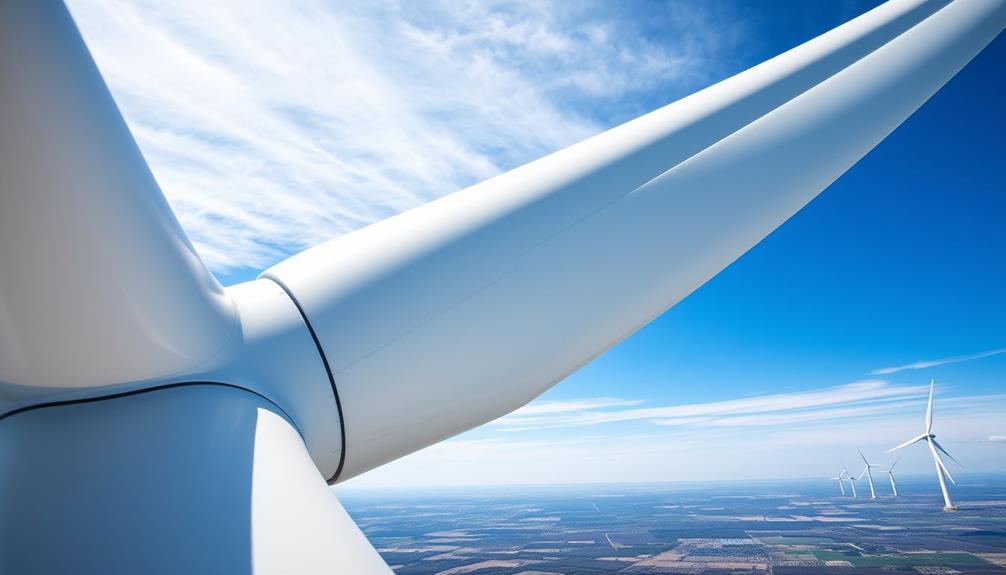
Several key factors influence the size of wind turbine blades, greatly impacting their efficiency and power generation capabilities. One major aspect is the relationship between blade size and wind swept area. By doubling the blade length, you can quadruple the power capacity, allowing for more electrical energy generation. This increase is particularly important when considering varying wind speeds, as turbines can start generating electricity at just 6 mph but reach their maximum capacity at 25-30 mph.
Additionally, understanding potential risks and rewards of Bitcoin IRAs can parallel the importance of optimizing wind energy systems for sustainable energy demands.
However, structural integrity is a critical concern when designing larger blades. As the length increases, so do the risks of bending and flexing, which could compromise the turbine's performance. To tackle this challenge, manufacturers use advanced materials and innovative turbine designs that support these larger blades while maintaining durability.
The trend toward larger blades is also seen in groundbreaking models like the GE Haliade-X, which aims to capture higher wind speeds more effectively. Ultimately, the combination of blade size, structural integrity, and turbine design plays a pivotal role in optimizing the efficiency of wind energy systems, ensuring they can meet growing energy demands sustainably.
Record-breaking Blade Measurements
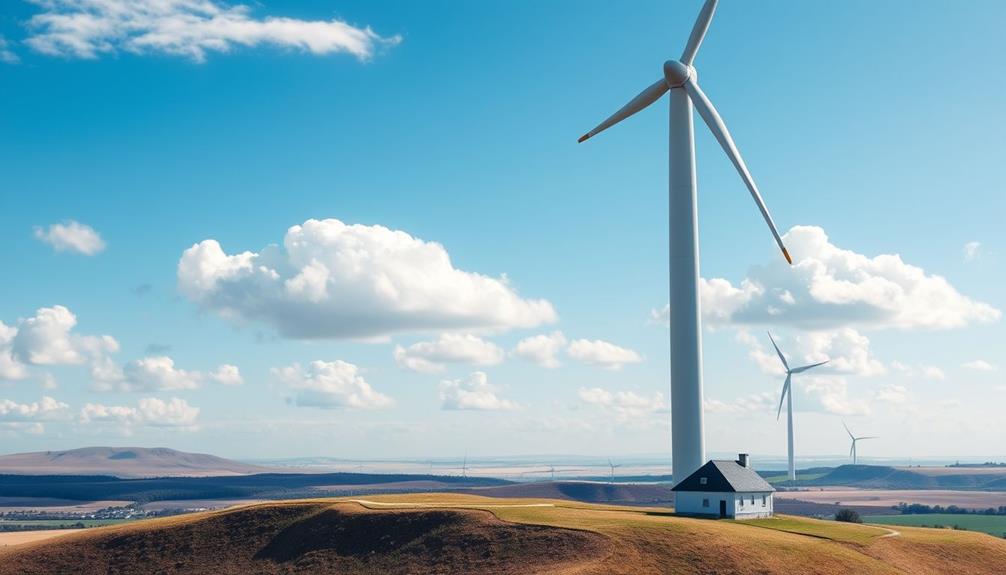
Record-breaking blade measurements are transforming the landscape of wind energy. With innovations like the GE Haliade-X, which boasts blades measuring an astounding 107 meters, wind turbines are now more efficient than ever. Offshore wind turbines have also embraced longer blades, often exceeding 100 meters, enhancing their ability to capture wind energy and increase power output.
Here's a quick comparison of some notable wind turbine blade lengths:
| Turbine Model | Blade Length (meters) |
|---|---|
| GE Haliade-X | 107 |
| Vestas 7.2 MW | 84 |
| Future Projections | Up to 1000 |
| Offshore Turbines | >100 |
| Onshore Turbines | <100 |
These record-breaking lengths allow turbines to harness more wind energy, leading to greater efficiency and sustainability in renewable energy production. As we look to the future, advancements indicate that blades could reach lengths of up to 1 kilometer, pushing the boundaries of what wind turbines can achieve. This evolution not only highlights the potential for increased power output but also emphasizes the importance of wind energy in our shift to sustainable energy solutions.
Engineering Challenges and Solutions
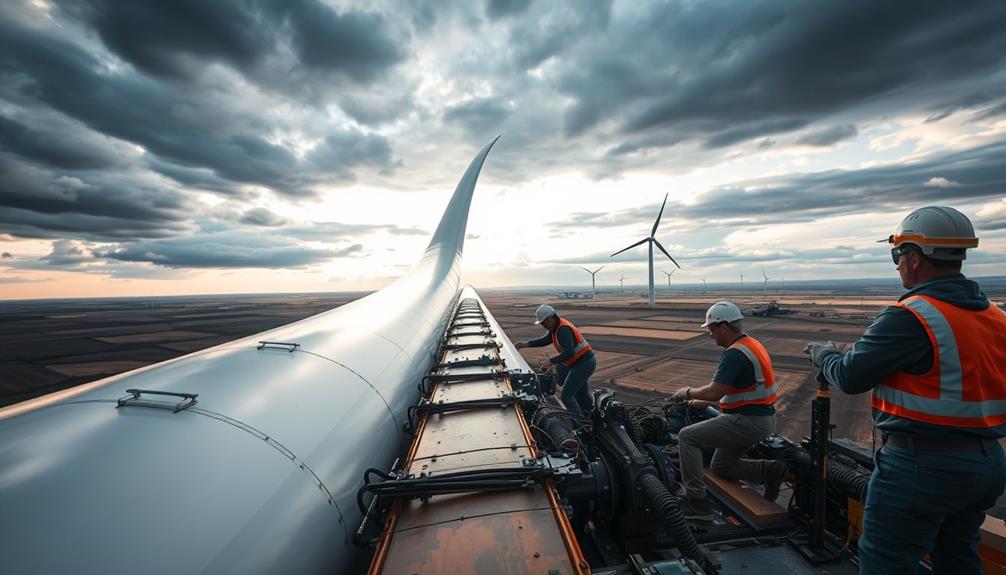
As wind turbine blades grow in size, engineers face a host of challenges that come with these advancements. Modern wind turbine blades can exceed 107 meters, creating significant engineering challenges for transport and installation.
The square-cube law complicates things further, as power generation scales with the square of the length, while mass scales with the cube, impacting structural design and material selection. The importance of effective maintenance is vital, as engineers must guarantee that these large structures can operate efficiently and reliably throughout their lifespan, similar to how the best heat pumps function in varied climates.
To overcome these hurdles, engineers utilize innovative solutions, including:
- Carbon fiber: This advanced material helps reduce weight while maintaining strength.
- Structural integrity: Guaranteeing the blades can withstand flexing and bending during extreme weather is essential.
- Floating offshore wind turbines: These designs allow for larger sizes and better energy generation potential in deeper waters.
Impact on Power Generation
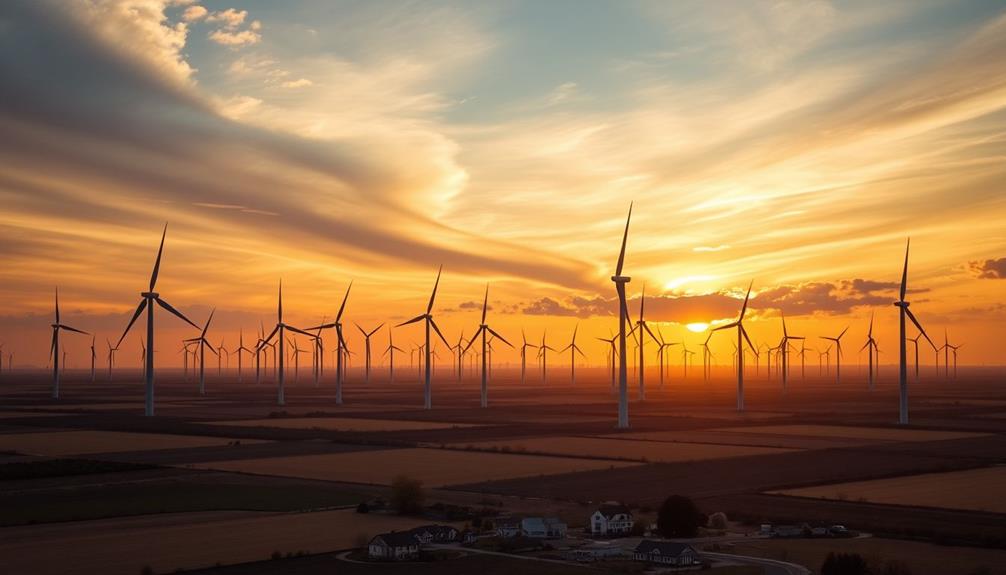
The growing size of wind turbine blades considerably boosts their power generation capabilities. With an average rotor diameter of 438 feet and blades averaging 210 feet long, the increased swept area allows for greater energy capture from the wind. This innovation not only enhances efficiency but also plays an essential role in diversification of retirement portfolio, as renewable energy investments become increasingly attractive.
When you double the blade length, you can quadruple the power capacity due to this expanded area, underscoring the significance of blade size in maximizing turbine efficiency.
Wind turbines typically generate electricity at wind speeds of 6 mph and reach peak capacity between 25-30 mph. Long blades effectively capture these higher wind speeds, resulting in enhanced energy output. For instance, the GE Haliade-X, boasting blades that are 107 meters long, can produce enough energy to power a home for two days with just one rotation.
In 2023, wind energy supplied over 10% of U.S. electricity, with states like Iowa and South Dakota exceeding 50% contributions to their power needs. This illustrates that advancements in blade size and turbine efficiency are essential for increasing reliance on renewable energy sources, paving the way for even more megawatts (MW) of clean energy generation in the future.
Future Trends in Blade Design
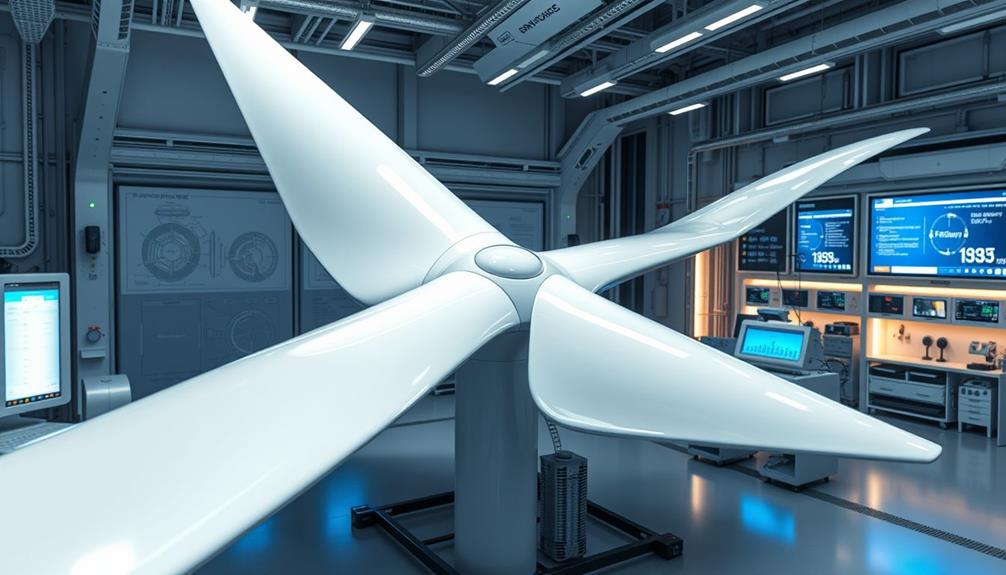
Advancements in wind turbine blade design are on the horizon, promising to revolutionize the industry further. Future trends suggest that blades could stretch up to 200 meters, pushing the limits of what you thought possible.
With innovations like 3D printing and carbon fiber, you'll see larger, lighter blades that enhance aerodynamic efficiency while slashing material costs. This aligns with the growing emphasis on mastering the art of bug out bags to guarantee preparedness in emergencies.
- Imagine a 20 MW turbine equipped with 123-meter blades, designed for offshore wind applications.
- Visualize multi-rotor systems that can harness more energy from the wind, optimizing performance.
- Picture floating offshore wind farms, accommodating these massive structures while capturing wind energy in new ways.
As research focuses on maximizing aerodynamic efficiency, future designs could allow for larger blades without compromising structural integrity.
The industry is evolving, and these advancements will make wind power not just more efficient but also more powerful. You'll witness a shift where the challenges posed by larger blades are met with innovative solutions, guaranteeing that the future of wind energy is brighter and more sustainable than ever.
Get ready to embrace these exciting developments in blade design!
Comparison With Other Energy Sources
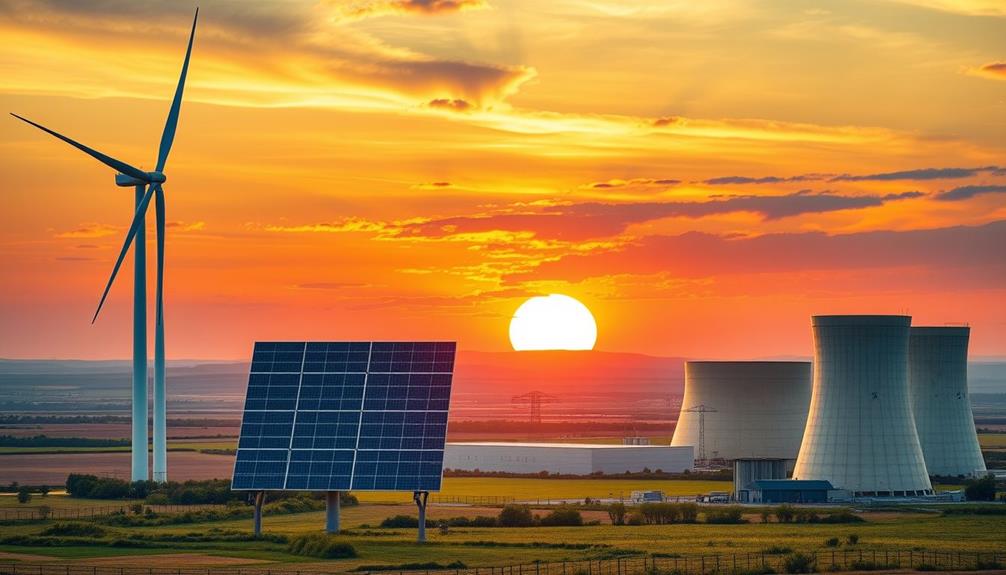
When you compare wind energy to other sources, its economic advantages become clear. With recent contracts averaging just 2.5 cents per kWh, wind energy is now competitive with fossil fuels and other renewables. In 2023, wind energy accounted for over 20% of electricity generation in 12 states, demonstrating its considerable role among energy sources.
Additionally, the growth of investment options, such as Gold IRAs, showcases a trend towards diversifying portfolios in the renewable energy sector. The average nameplate capacity of utility-scale wind turbines reached 3.4 MW this year, showcasing their ability to produce substantial power. This starkly contrasts with the stagnation seen in fossil fuel sectors, where growth has been minimal. The rapid expansion of wind power, with over 45 GW of new capacity installed in the U.S. since 2020, reflects a clear shift towards renewable energy.
Moreover, modern wind turbines boast an average rotor diameter of 438 feet, highlighting the technological advancements that enhance efficiency and output compared to traditional energy systems. As you consider the future of electricity generation, it's evident that modern wind power stands out as a leading, efficient, and economically viable energy source.
Embracing wind energy can considerably contribute to a sustainable energy future.
Frequently Asked Questions
How Long Are Modern Wind Turbine Blades?
Modern wind turbine blades can reach impressive lengths, often exceeding 107 meters. These massive structures enhance energy production, with future advancements possibly pushing lengths to a staggering 1 kilometer, revolutionizing renewable energy generation.
What Is the Best Length for a Wind Turbine Blade?
When it comes to wind turbine blades, finding the sweet spot is key. You'll want a length that maximizes power while keeping structural integrity intact—too long, and it's like chasing the wind.
How Does Blade Length Affect Wind Power?
Blade length considerably affects wind power since longer blades sweep a larger area, capturing more wind energy. This increase boosts efficiency and power generation, demonstrating why turbine design prioritizes maximizing blade length for ideal performance.
What Is the Maximum Length of a Wind Turbine Blade?
The maximum length of a wind turbine blade currently stands at around 107 meters, but future designs could potentially reach up to 200 meters, considerably enhancing power generation capacity and efficiency in wind energy production.
Conclusion
To summarize, the evolution of wind turbine blades reflects humanity's relentless pursuit of efficiency and sustainability. As you explore the impressive lengths and engineering feats behind these structures, it's clear they play a pivotal role in our energy landscape. With advancements on the horizon, the future of wind power looks promising, rivaling even the most illustrious innovations of yesteryear. Embracing these changes not only propels us toward greener energy but also guarantees a legacy for generations to come.
